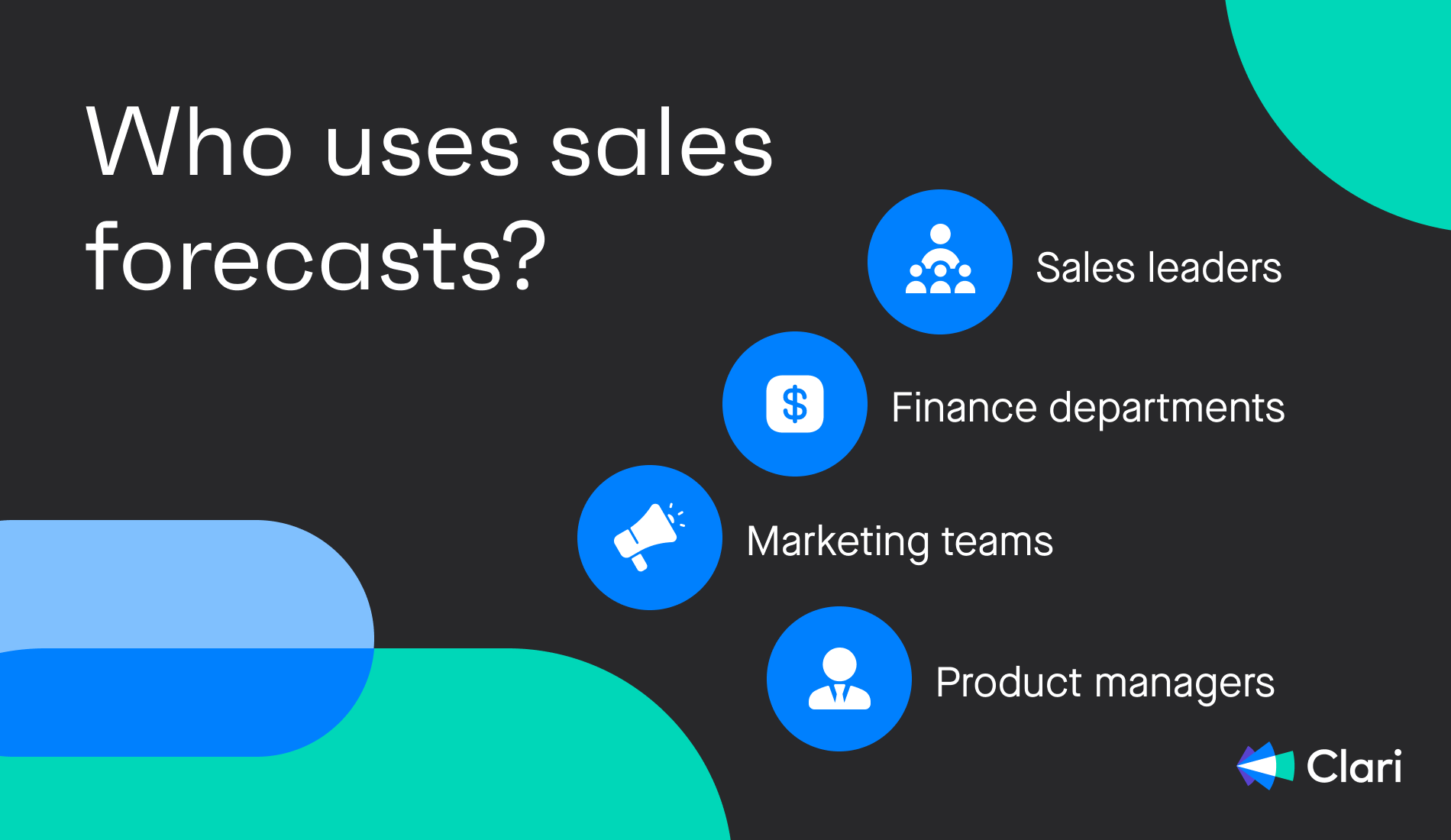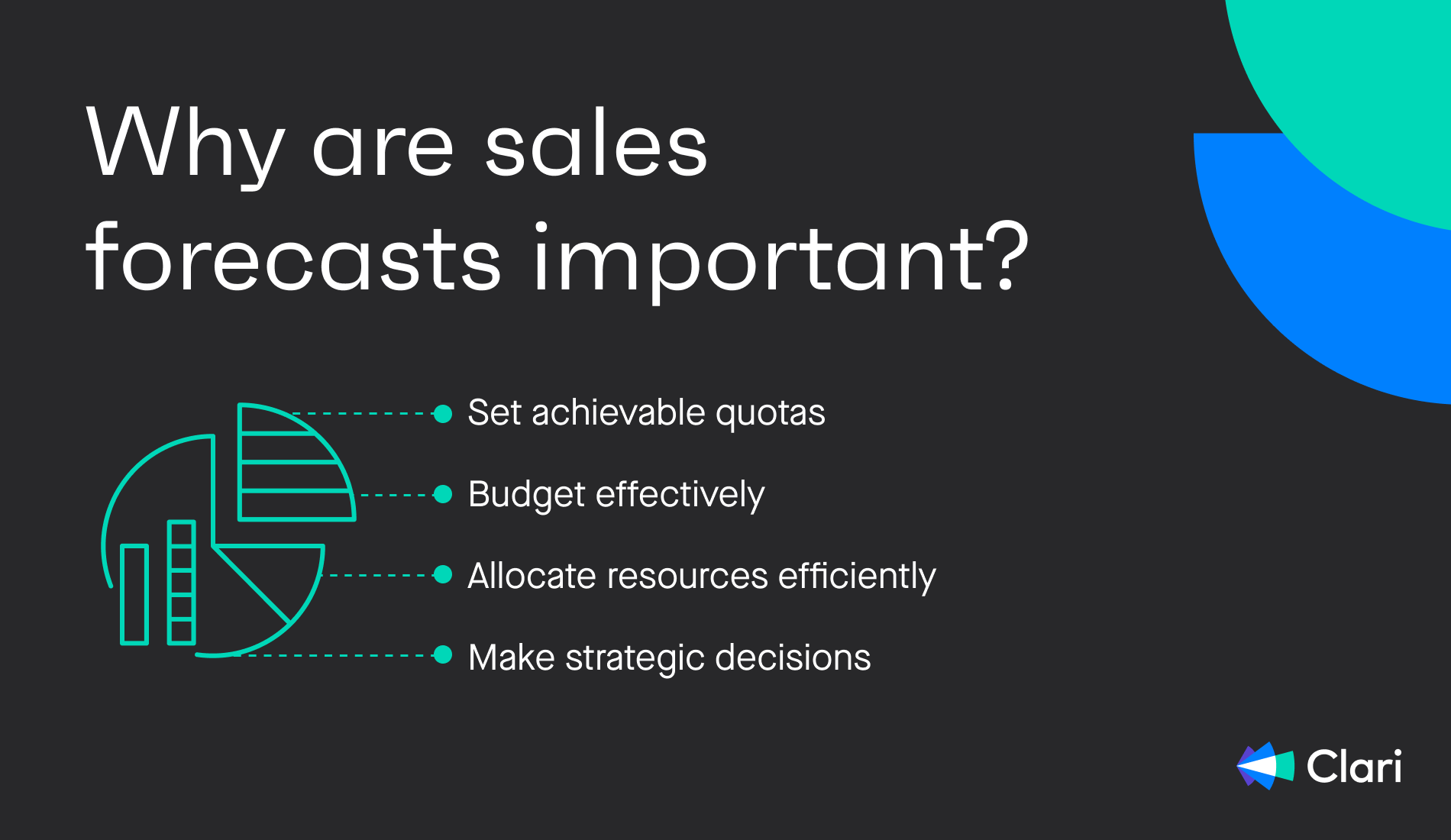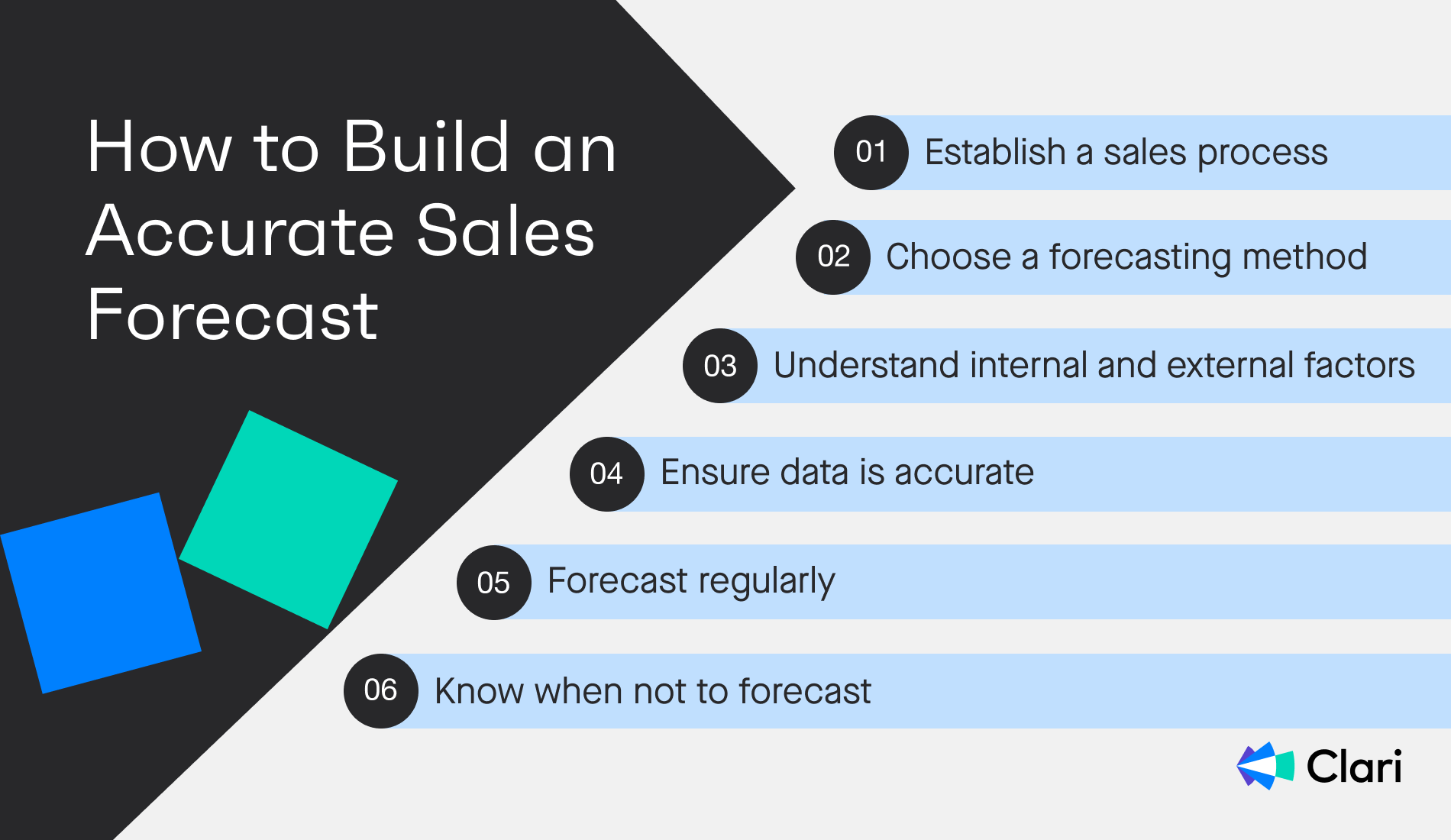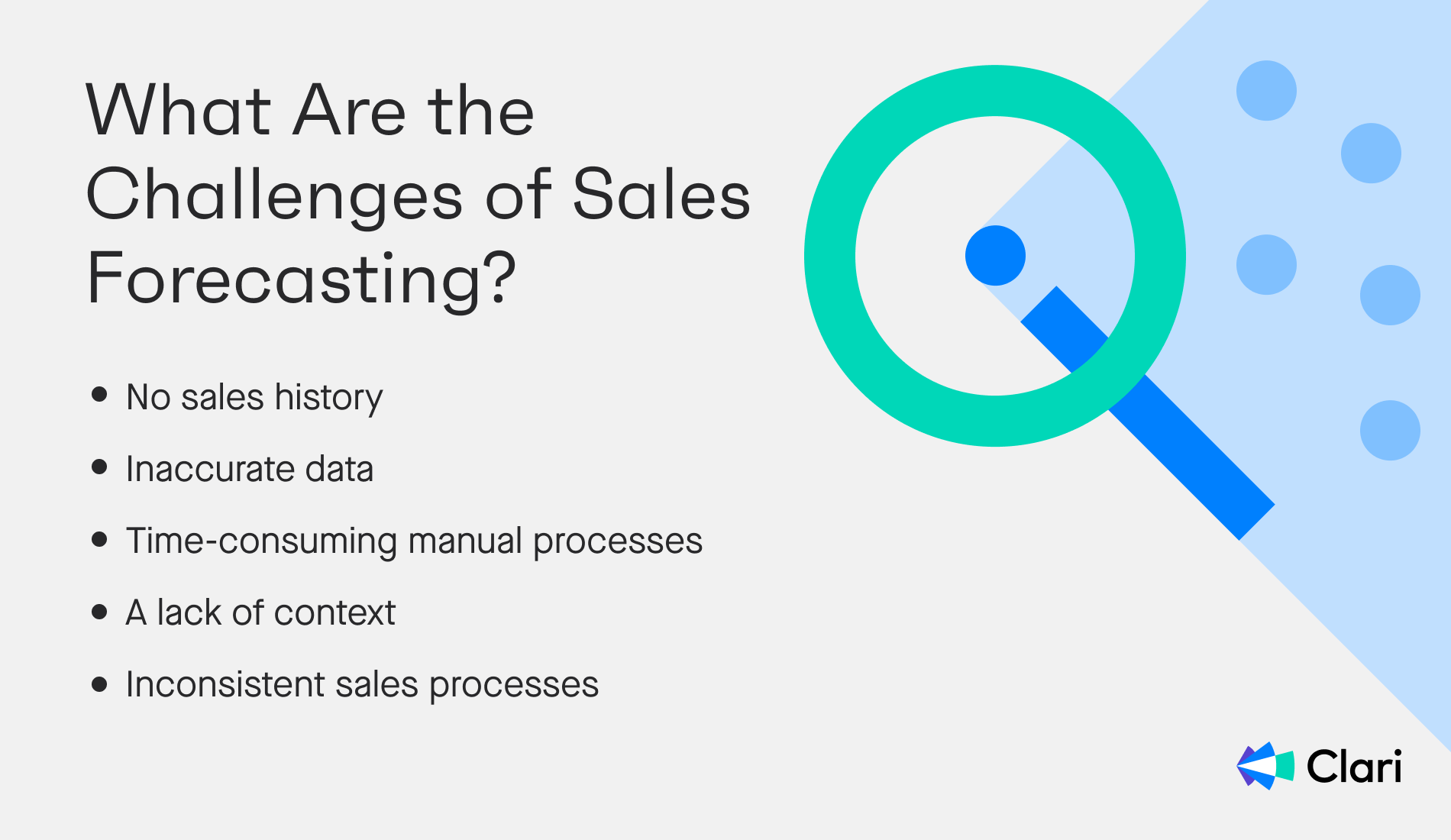Every sales leader wants to make smart targets, budgets and hiring decisions. But that’s next to impossible if you don’t know how much your team should sell over the next quarter or year.
Eighty percent of sales organizations miss the mark on their forecasting by 25% or more. That’s why knowing how to create an accurate sales forecast is important.
Whether it’s your first time building a sales forecast or you’re looking for a refresher, we’re here to help. In this article, we’ll cover the basics of sales forecasting, show you how to build an accurate forecast from scratch, and discuss some of the challenges you may need to overcome.
Table of contents
- What is sales forecasting?
- Why is sales forecasting important?
- Steps for accurately building a sales forecast
- Sales forecasting keys to success
- Top challenges with sales forecasting
- Tools for sales forecasting
- What’s next?
What is sales forecasting?
Sales forecasting is the process of predicting future revenue by estimating how much a salesperson, team, or company will sell in a week, month, quarter, or year. Sales forecasts are often made with past performance data. A good one will use one of several forecasting models to analyze a range of factors, including historical performance and your current sales pipeline, to predict future outcomes.
You could use several popular types of forecasting models, including:
- Opportunity stage forecasting
- Historical forecasting
- Length-of-cycle forecasting
Don’t worry; we’ll go into each of these in more detail later on in the article.
A sales forecast can tell you much more than your potential income. You can use them to predict future hiring needs, budget effectively and decide whether or not to pursue a new growth opportunity.
Who is responsible for sales forecasting will depend on the size and structure of your organization. In most cases, sales leaders are responsible for sales forecasting. That could be a team leader, a sales manager or a VP of sales.
These aren't the only people who will run forecasts, though.

Finance departments will also run sales forecasts to determine budgets and investment opportunities.
Marketing departments will use them to analyze how the company can meet targets and find new growth opportunities.
Product managers will use sales forecasts to determine inventory levels and assess product demand.
Why is sales forecasting important?
Sales forecasting helps sales leaders set reasonable goals and quotas for their teams to gauge performance, course-correct any issues, and make budget and spending decisions. Without an accurate sales forecast, sales teams can become unmotivated and businesses stand to overspend.

Set achievable quotas
Sales forecasts help sales leaders set realistic and attainable targets for their teams. Yes, believe it or not, most managers aren’t plucking these figures out of thin air. They are based on a detailed analysis of past performance, current opportunities and the business’ growth goals.
Budget effectively
Sales forecasts are revenue forecasts at the end of the day and, as such, are vital in creating accurate budgets. When you have an estimate of how much revenue you expect to generate in the coming months, you can make informed decisions about how much to spend on things like marketing and hiring.
Allocate resources efficiently
Sales forecasts can also be used to estimate future growth and help businesses plan more effectively. Leaders can decide where to prioritize resources for maximum impact or to overcome upcoming challenges.
Make strategic decisions
Sales forecasts contain a mountain of insights that leaders can use to make decisions about the future of a business. On one level, they can be used to optimize your sales strategy. Dig a bit deeper, however, and the insights they uncover can be used to take advantage of new opportunities or make informed decisions on growth-orientated projects such as product launches. For example, If sales are trending and revenues are on the rise, it may be a good time to invest in that new product.
Steps for accurately building a sales forecast
While there’s no sales forecast formula or magic pill to come up with accurate real-time sales projections, here are six steps to make sure that your sales forecasts are effective:

1. Establish a solid sales process
A well-defined sales process is fundamental to a sales forecast. Ensure you have clear definitions of leads, opportunities, pipeline stages, and other sales funnel elements. And make sure every salesperson is familiar with these elements and knows how to qualify leads and close deals.
More importantly, they must understand the importance of tracking and updating that information using your sales tech stack—be it a CRM, a marketing automation platform, or a conversation analytics solution like Clari Copilot.
2. Choose a forecasting method depending on the purpose and use case
Before studying various forecasting methods or tools, it’s important to understand the purpose of the forecast and its use. That dictates the next steps.
After establishing the purpose and the use case, choose a sales forecasting method depending on your situation.
For example, if you wish to improve your performance in a certain region, you can look at your past sales data and use statistical models to estimate future sales.
However, if you’re trying to understand customer demand for a new product or new business, you don’t have any historical data and must rely on market research, competitor analysis, and insights from expert sales leaders within your sales organization.
A forecasting method that relies on qualitative data might be better for such scenarios.
You can choose from several forecasting methods, including:
Historical data forecasts
Historical data forecasts analyze your historical sales data to spot patterns and estimate future sales, provided the conditions remain the same. Historical forecasting using past sales data is one of the simplest sales forecasting methods and doesn’t require any complex forecasting models or software. It is ideal for short-term forecasting when external changes don’t lead to radical economic changes. It's also useful to assess sales performance for a specific time frame by comparing it to sales data from previous years.
Pipeline-based forecasts
The pipeline forecasting method is a sophisticated yet reliable technique to predict sales performance accurately. It analyzes each opportunity in your sales pipeline to calculate its conversion rate using pre-defined variables such as opportunity size or win rate.
So, you can consider every factor, such as the deal age and value, to get more accurate results.
However, like the previous two methods, this technique only works if your sales team keeps track of all the essential sales data, preferably in real time.
It also relies heavily on historical data and the maturity of the sales organization, so the pipeline forecasting method might not be ideal for early-stage startups.
Length of sales cycle
The sales cycle forecasting method calculates your predicted sales by analyzing the age of an individual opportunity.
To get started, you must find out your average deal cycle—add the total number of days it took to close each of your recent deals, then divide that by the number of closed deals. The next step is to map how far along the sales cycle your reps are and estimate their chances of closing the deal within a given timeframe.
Like the opportunity stage sales forecasting method, sales cycle forecasting is straightforward and objective. However, it doesn’t take into account the age and worth of each deal.
Moreover, your sales reps must regularly and meticulously track and update all sales pipeline data for this method to be accurate.
Intuition based forecasts
Intuitive or qualitative forecasting uses information such as expert opinions or insights from your sales teams.
Since the sales reps are always involved in customer-facing conversations, they can provide valuable insights into future sales performance.
However, since this method relies on intuition rather than data, it won't be very objective and the resulting sales projections might not be accurate. That’s why it’s a technique you should use in addition to a more data-driven, scientific forecasting method.
Multivariable analysis
The multivariable analysis method considers qualitative and quantitative data to predict future sales. It considers factors such as:
- The average sales cycle length and total sales volume over any given period
- The probability of closing deals, depending on the type of lead, opportunity stage or marketing efforts
- The metrics of individual sales reps, such as win rate, monthly sales, conversion rates, close rates and quota attainment
This method is sophisticated and one of the most accurate sales forecasting methods.
However, it requires good quality and either real-time data or data that is continuously updated by sales reps. It also warrants an advanced analytics tool that can perform predictive analytics using large volumes of real-time data from various sources.
You should also use this to determine your forecasting period. Monthly, quarterly and annual forecasts are all common.
3. Understand the internal and external factors influencing the sales cycle and forecasting process
Internal factors such as changes to the company policy, operating regions, marketing strategy, sales process or overall business goals can affect your sales forecasts.
Similarly, external factors such as economic changes, geopolitics, new legislation, or market and demand fluctuation also influence the forecasting accuracy.
While you cannot anticipate such events, it’s a good practice to run regular forecasts and simulate the impact of a wide range of scenarios that can affect your sales performance and total sales.
4. Ensure that the sales data is accurate and updated in real time
According to a report on sales forecasting accuracy, salespeople spend about 2.5 hours each week on sales forecasting, and for most companies, the forecasts are less than 75% accurate. Two factors can help improve this scenario—data and technology.
Clean, accurate and credible data is at the heart of any forecasting method. That’s why it’s a good practice to monitor and update sales data often, regularly and with adequate context.
Moreover, you should consider consolidating data from other teams such as marketing, product, finance and customer success to build a more comprehensive data profile on each opportunity.
Likewise, pick a tool that automates real-time updates to the sales pipeline, monitors the performance of your sales reps intelligently with intuitive dashboards and integrates seamlessly with the rest of your tech stack.
5. Forecast regularly
You need to update forecasts regularly to keep them relevant and impactful. The solution? Make forecasts part of your monthly routine. This will let your sales team keep their fingers on the pulse.
6. Know when not to make a forecast
According to Paul Saffo, a Silicon Valley technology forecaster, the key to effective forecasting is knowing when to pause and wait for things to settle down rather than jumping to conclusions.
Black swan events such as pandemics or geopolitical tensions bring too much uncertainty. During such scenarios, it’s best to take a step back, observe how things settle down and begin forecasting once the new world order emerges.
Sales forecasting keys to success
If you want to make your forecasts more accurate and reliable, follow these tips:
Ensure your data is reliable
If you put garbage in, you get garbage out. Or, said another way, good data is crucial to the success of your sales forecast. You need clean and validated data if you want to create accurate forecasts.
Given that most of this data will come from your CRM, you ensure your sales team regularly updates it.
Don’t leave this up to chance, though. Make updating your CRM part of your sales process and set a quota for how often sales reps should update it — like adding or updating ten contacts daily.

Don’t rely only on your gut
You may think you have your finger on the pulse of your industry, but the data probably knows better.
Collect and refer to historical and real-time data over your intuition where possible. This may only sometimes be possible, especially if you are a brand-new company. But the more data you can collect, the better your forecasts will be.
Use forecasting tools
There’s no shortage of forecasting tools out there to choose from. And that’s for a very good reason.
These tools are incredibly useful. Swapping out spreadsheets for a dedicated tool increases the likelihood that your forecast will use the most relevant and up-to-date information.
Unlike spreadsheets, which require manual input to update, forecasting tools can automate the process.

In fact, the right tool can automate almost the entire forecasting process, from collecting data to analyzing it. As a result, you can get recurring 30-day sales forecasts from an intuitive dashboard without lifting a finger.
Review internal and external factors
Your sales forecast is built, in part, on assumptions you make about a range of internal and external factors. Make sure that you regularly review any changes in the following factors that could impact the reliability of your forecasts.
Market conditions are one of the biggest external factors derailing your forecast. Is your market shrinking alongside the economy, for example? You could overforecast as a result.
Seasonality and regulatory changes are other external factors that can impact the reliability of your forecast. You should be able to account for seasonality using historical data, but it can be hard to predict regulatory changes in advance.
Changes to your product and services are the most prominent internal factor you need to review. For example, a new feature or product could increase your product’s total addressable market. Fail to account for this, and you could underforecast.
Use a checklist
Hopefully, by now, you can see just how many moving parts there are when creating an accurate forecast. Unfortunately, it’s all too easy to miss one thing that could jeopardize your forecast.
Don’t leave that outcome to chance.
Instead, use a forecast checklist to ensure you cover every base. From scoring deals in your pipeline to validating outcomes, our checklist will ensure you forecast with accuracy every time.
Top challenges with sales forecasting
Sales forecasting isn’t easy, even when you follow the steps outlined above. Many organizations face a range of challenges, including the following:

No sales history
Past sales data is one of your most important assets when creating a sales forecast. This presents a real challenge to startups that just don’t have that data to hand.
Unfortunately, you can’t do much about this except focus on gathering as much data as possible and using forecasts that don’t rely on historical data—like intuition-based forecasts—until you’ve closed more deals.
Inaccurate data
Inaccurate or incomplete data is probably worse for your forecasts than not having data at all. At least when you lack data, you can take forecasts with a pinch of salt.
But when you rely on forecasts that use inaccurate data to make strategic decisions about your company's future, you risk ruin.
Let’s say you decide to hire more sales reps based on an overforecast that predicts you will make triple the sales you do in reality. That’s an enormous increase in your overhead costs with very little change in your bottom line.
Time-consuming manual processes
Forecasts are hard work. But sales reps already spend just 23% of their time selling.
You don’t want them to waste any more time. Yet that’s exactly what happens with sales forecasting that relies on too many manual processes.
Luckily, there’s a simple solution to this challenge. Use sales technology like a CRM or revenue platform to automate as much of the process as possible.
Lack of context
Sometimes, sales data only shows numbers without context behind the change. Take the pandemic, for example. If you were a seller of standing desks, you may have experienced a huge spike in demand caused by people working from home.
Without context to understand why that increase occurred (and why record sales may not last), you risked over-forecasting sales when normality resumed.
Inconsistent sales processes
If sales funnels and processes differ too much between reps, it can be hard to make accurate predictions—especially if you use a funnel-based forecasting method.
That’s why you should first establish a solid and repeatable sales process when creating a forecast. Your forecasts become much more accurate when everyone uses the same pipeline stages and definitions.
Tools for sales forecasting
Having the right tools can make your sales forecasting faster, easier and more accurate.
CRM
If you haven’t gathered already, data is the lifeblood of an accurate sales forecast. You need a CRM that integrates with all of your sales tech stack and records (and stores) copious amounts of clean data.
In fact, it would be almost impossible to create a sales forecast without a CRM.
Not just any CRM will do, however. Improve the efficiency and effectiveness of your forecasting by choosing one with the following features:
- Contact management
- Automated data collection
- A mobile CRM
- Analytics, reports and dashboards
- Third-party integrations
Revenue platform
A revenue forecasting platform like Clari can significantly accelerate your forecasting process.
It will automate many of the processes and allow you to create more complex and insightful forecasts because of its ability to track way more variables than you could with a spreadsheet.

Built-in dashboards and analytics make it easy to generate insights at a glance and start putting forecasts into practice.
What’s next?
Sales forecasting is vital for any organization that wants to make better decisions, set accurate sales targets and allocate resources effectively.
And while it’s not that difficult to run sales forecasts, they can still be time consuming. That’s unless you have a revenue platform to automate the process, of course.
Take a product tour to learn how Clari can fulfill your sales forecasting needs or read our guide to forecasting confidence to learn how you can improve your forecasting even further.



